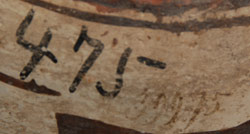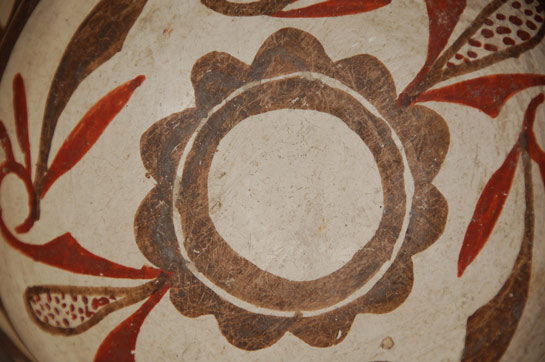Historic Nineteenth Century Polychrome Bowl, circa 1870s [SOLD]
+ Add to my watchlist Forward to Friend
- Category: Historic
- Origin: Zuni Pueblo, SHE-WE-NA
- Medium: native clay and pigments
- Size: 7-3/4” diameter x 3-1/2” deep
- Item # C3361B SOLD
 One can almost feel the peacefulness at sunset as the sky turns from a fiery red to yellow. Rarely do we see Zuni bowls with a red underbody. Since the late-1800s, most potters have used black. According to Batkin, "Zuni Polychrome vessels retained the red rim and underbody slip of Ashiwi Polychrome until the late eighteenth or early nineteenth century, when it was replaced by dark brown paint..." ¹
One can almost feel the peacefulness at sunset as the sky turns from a fiery red to yellow. Rarely do we see Zuni bowls with a red underbody. Since the late-1800s, most potters have used black. According to Batkin, "Zuni Polychrome vessels retained the red rim and underbody slip of Ashiwi Polychrome until the late eighteenth or early nineteenth century, when it was replaced by dark brown paint..." ¹
The paste materials are typically Zuni; white and chunky in texture with the centuries old temper material of ground pottery shards. The use of old shards for temper evidences the regard of the pueblo peoples for the old works made by their predecessors. To add these remnants to the new work is a sign of respect.
The rim of the bowl curves inward slightly, imparting a graceful shape to what could otherwise be an uninteresting one. The interior of the rim flexes slightly, an unnecessary added feature that enhances its shape. The bowl is slipped in traditional fashion with cream-colored clay, over which is painted the designs in mineral and vegetal paints. The exterior is decorated with the traditional prayer stick design used on every Zuni bowl made in the nineteenth century. It is thought that this was a woman's way to place her prayers since women do not make prayer sticks.
The interior decoration begins with a brown rim, below which is a series of rectangles divided into triangles encircling the bowl that are rendered solely in brown. Below this are two wide parallel framing lines with a very distinctive ceremonial break. Two Zuni volute design elements in brown paint fill the interior of the bowl. These are attached to two corn-like elements, executed in red without outlining. The bottom has a double circle, one of which is cloud-like, outlining an otherwise undecorated center. On the exterior of the bowl is written the numbers 39975 in beautiful hand Script. This is most certainly an acquisition number placed there by one of the earlier expeditions to Zuni.
1. Reference: Pottery of the Pueblos of New Mexico: 1700-1940. Jonathan Batkin. The Taylor Museum of the Colorado Springs Fine Arts Center. 1987.
UPDATE INFORMATION: Dwight Lanmon so kindly provided the following information. The numbers 39975 are BAE accession numbers indicating that Stevenson collected the bowl in 1879 on the Powell Expedition. He confirmed with the Smithsonian that the numbers 475 are Stevenson's field numbers.

- Category: Historic
- Origin: Zuni Pueblo, SHE-WE-NA
- Medium: native clay and pigments
- Size: 7-3/4” diameter x 3-1/2” deep
- Item # C3361B SOLD



